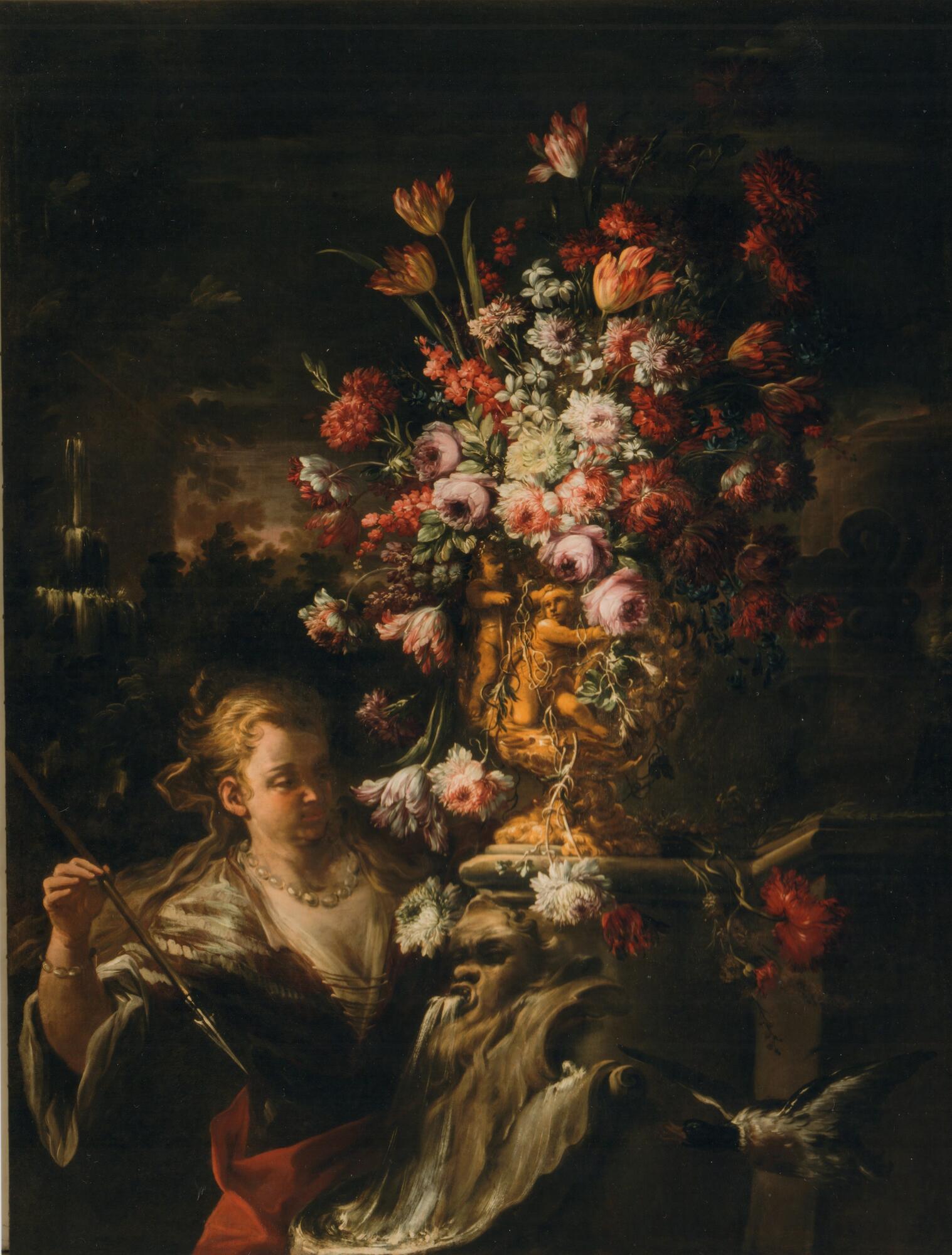The painting “Still life with flowers and a female half-figure” came to the museum in 1918 from the Karacharovsky estate “Red Mountain” of the Counts Uvarov. In the museum’s inventory books, the artist’s name is given with the dates of his life: 1635-1681, which suggests that the paintings were attributed to Gaspar Peter Verbruggen the Elder. However, such compositions with images of female figures are not quite characteristic for this master and rather appear in the works of his son, Gaspar Peter Jr., who in such cases collaborated with other artists. It is assumed that two artists created this canvas which was a very common practice: one painted magnificent bouquets of flowers with noticeable grace, the other worked on painting the figure. Gaspar Peter Verbruggen Jr. (1664-1730) is Flemish artist, master of floral still life in the genre of late Baroque. He was taught painting by his father Gaspar Verbruggen Sr. The characteristic canvas of Verbruggen’s son “Flora” is in the Radishchev Museum in Saratov. It depicts the goddess of spring, next to her is the god of love Cupid.
In our exposition, a large vertical canvas in the foreground depicts a lush floral arrangement in a vase. The stone vase is mounted on a pedestal, at the bottom of which there is a fountain in the form of a man’s head. Behind the figure of a young girl, another higher and larger fountain is painted.
Flowers deserve special attention in Verbrugenne’s works. In the XVII — beginning of the XVIII century, the “language of flowers” appeared and quickly spread throughout Europe, and then it came to Russia. According to legend, this oriental exotic was brought to Europe by the Swedish king Charles XII — the same one who was defeated near Poltava by Peter the Great. After the defeat, he disappeared, lived at the court of the Ottoman Sultan, there he learned the “language of flowers”.
The “language of flowers” had many subtleties and nuances. When are the flowers presented? Which hand holds the bouquet, the right or the left? If the one to whom the bouquet was presented tilted it to the right — then this means consent, if to the left — refusal. If she pinned it to her corset, next her heart, then she loves it, and if she put it in her hairstyle, it’s a warning.
In our exposition, many plants are depicted. Each flower has an established meaning. The tulip symbolizes the expression of love. Dahlia is dignity and elegance. Carnation means purity. The most popular flower is a rose. What meanings it is endowed with: love, passion, virtue, courage, beauty, infinity, poetry, etc. In ancient Rome, the rose was endowed with an unusual meaning — it became a symbol of silence. During the feasts, an artificial rose hung from the ceiling of the hall — it was dedicated to the god of silence Harpocrates. In Nero’s Rome, it was a useful reminder. The emperor’s spies listened to drunken speeches at feasts. Rose saved the life of more than one gossip.
In our exposition, a large vertical canvas in the foreground depicts a lush floral arrangement in a vase. The stone vase is mounted on a pedestal, at the bottom of which there is a fountain in the form of a man’s head. Behind the figure of a young girl, another higher and larger fountain is painted.
Flowers deserve special attention in Verbrugenne’s works. In the XVII — beginning of the XVIII century, the “language of flowers” appeared and quickly spread throughout Europe, and then it came to Russia. According to legend, this oriental exotic was brought to Europe by the Swedish king Charles XII — the same one who was defeated near Poltava by Peter the Great. After the defeat, he disappeared, lived at the court of the Ottoman Sultan, there he learned the “language of flowers”.
The “language of flowers” had many subtleties and nuances. When are the flowers presented? Which hand holds the bouquet, the right or the left? If the one to whom the bouquet was presented tilted it to the right — then this means consent, if to the left — refusal. If she pinned it to her corset, next her heart, then she loves it, and if she put it in her hairstyle, it’s a warning.
In our exposition, many plants are depicted. Each flower has an established meaning. The tulip symbolizes the expression of love. Dahlia is dignity and elegance. Carnation means purity. The most popular flower is a rose. What meanings it is endowed with: love, passion, virtue, courage, beauty, infinity, poetry, etc. In ancient Rome, the rose was endowed with an unusual meaning — it became a symbol of silence. During the feasts, an artificial rose hung from the ceiling of the hall — it was dedicated to the god of silence Harpocrates. In Nero’s Rome, it was a useful reminder. The emperor’s spies listened to drunken speeches at feasts. Rose saved the life of more than one gossip.



